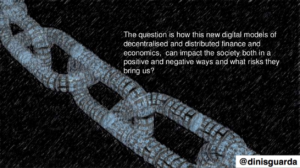Like napalm, blockchain is a portmanteau word, and you just have to sniff to sense how pervasive it is becoming in emerging technology conversations across the business landscape. It’s a technology that’s on the lips of VCs, strategists and industry watchers talking about their next big idea and often framed as the next stage of evolution of the Internet. A word that appears in the first sentence of the elevator pitch of many new technological ideas or solutions. Does it need to be there or is it some pivot to hook on to the latest trend? A Techcrunch piece last month started with:
“Demand is off the charts for blockchain talent, and the capital is waiting to back it up. More than $3.7 billion has been raised through ICOs in the United States alone.”
Here we are less than 3 months in to 2018 and several days in to the the usual hype and excitement that surrounds the eclectic SXSW “technology meets entertainment” event currently going on in Austin, Texas, and I’m wondering whether this is an emerging technology that can be a force for good, or something that will take us to the heart of darkness.
We’ve been here before
This period in the blockchain hype cycle feels a lot like when we started talking Software as a Service in the mid 2000s and then Cloud Computing back in 2007. Those of us there at the start of solutions based on SaaS (along with infrastructure and platforms as a service) worried about every provider with a hosted solution of some kind slapping on ‘aaS’ initially and then the ‘Cloud’ label to their offerings to ride the wave, and we had endless discussion and argument around what was “pure cloud” and what was “same old software as a service”. We came up with definitions and tried to apply standards and it got messy. In moving beyond the regular misuse and misunderstanding of the term, though, cloud computing became a useful catch all for the paradigm shift that was happening around us – the consumerization and commoditisation of IT services as part of the “Big Shift” and a core component of what Agile Elephant calls the Digital Enterprise Wave. Blockchain’s following a similar course in much choppier waters.
Last week Adrianne Jeffries’ piece on The Verge worries that the blockchain term has become so widespread and misused that it’s quickly losing meaning, quoting David Gerard, author of Attack of the 50 Foot Blockchain: Bitcoin, Blockchain, Ethereum & Smart Contracts, saying in an email:
“What is a ‘blockchain’? The word is a buzzword that is increasingly ill-defined,”
He has a point. Some people know what they are talking about, but when others say blockchain do the really just mean a secure, distributed database of some kind? There is both bad and good information on this, with bad and good definitions out there. For example, when I was researching this article I found a Fortune/Bloomberg piece from last December titled Blockchain Is Pumping New Life Into Old-School Companies Like IBM and Visa, that contains the sentence: “The blockchain can also hold many more documents and data than traditional database storage, allowing for more nuanced insights and analysis.” Now that’s rubbish on many levels, and dangerous too.
We need some clarity
That’s exactly why I’ll try to explain what blockchain is by answering the question “what’s the difference between a blockchain and a traditional database?”. As well as following my explanation, I want to refer you to three sources. Please read CEO of Integra Ledger, David Fisher’s excellent guest post on Artificial Lawyer – What Really Is Blockchain and Why Does It Matter to Lawyers? Also read Shaan Ray’s Blockchains versus Traditional Databases, and finally here on the AE blog, Alan Patrick’s Blockchain Economics – the Reality. Can your application afford the transaction costs?
What is blockchain?
A blockchain is a distributed (or decentralised) ledger, implemented across many networked servers, consisting of a continuously growing list of records, called blocks, which are linked across the whole network and secured using cryptography. This technology allows several parties or competitors to share a digital ledger across the network of computers without the need for a central authority. The combination of cryptography and the fact that each block addition is “witnessed” across many servers means that, in practice, no single party has the power or resources to tamper with the records. The problem we are solving here is trust. Blockchain’s key advantage is that the parties or competitors can trust the digital ledger without the need for any intermediary like a bank or broker or lawyer or government being involved. How disruptive is that!
What’s the difference between a blockchain and a traditional database?
Traditional databases are based on CRUD. No, not rubbish, but the concept that somebody has the ability to write a program that creates, reads, updates or deletes individual records in a database sitting on storage connected to a central server somewhere. Somebody has the administration rights for that database. Depending on the particular database technology and the way the software accessing it is designed, any changes might be tracked by who made the change, date and time stamped, and then duplicated somewhere else for backup and recovery purposes. You can use all sorts of security measures and cryptography to protect the integrity of the data, but two things remain true. First, some one person or central authority has administration rights to keep the data secure and control access on everyone’s behalf. Second, the individual records in the database can be changed. If a malicious agent wants to beat the cyber security measures put in place so that they can hack the data, they have one place to work and do their dirty work.
Blockchain databases consist of several, distributed compute server and storage nodes, all of which participate in the administration and verification of the data all of the time. Instead of CRUD, blockchain technology can only create and read. Somebody writing the program to use this kind of database can only read existing blocks and add or append additional blocks. The blockchain technology performs only two functions – the validation of existing transactions and the addition of new ones. All of the nodes in the network are capable of adding new blocks. All of the nodes of the network verify every existing and new block. That means that the malicious agent who wants to beat the cryptographic encryption needs to do that simultaneously on all the nodes of the network, making it so difficult and expensive in compute power (with current technology) as to be impossible in practice. That’s why this form of distributed ledger technology can be considered immutable. That’s why you can trust a blockchain ledger.
What works, what doesn’t, what’s next?
As Alan’s post here on the Agile Elephant blog highlighted there are places where this technology is appropriate and works well. What is worrying is that not everyone is understanding or considering the compute power required by the distributed blockchain model where every add must be verified across all of the nodes of the network, and that has an effect on the rate of transactions you can put through this type of database compared to a traditional centralised one. There are a lot of applications currently being suggested for blockchain that won’t be able to cope with that operational and economic overhead. Alan puts it succinctly when he suggests:
“Somewhere between the hype, hope and heuristics is a major disconnect”
 So what happens next and can blockchain be a force for good? To answer that question I asked our good friend, author, fintech expert and entrepreneur Dinis Guarda. Dinis and I both lecture on Groupe INSEEC’s digital marketing MBA programme. Back in September 2016 he spoke on IoT and Blockchain at one of Agile Elephant’s regular meetup sessions, explaining his belief that blockchain in the IoT will not be implemented without significant platform development by companies with deep pockets. Then at the Enterprise Digital Summit Paris in 2017 he keynoted on “Blockchain and the Decentralisation of Business”. He’s considered one of the top blockchain and cryptography influencers in the world, and most recently his company Ztudium sold their blockchain and cryptocurrency with rewards tokenization platform called Blockimpact to Canadian firm Glance Technologies. Glance owns and operates Glance Pay, a streamlined mobile payment system, and Dinis is now on their advisory board. Talking to him around blockchain he recognises that, like any tool, it can be used for good and bad, but it needs to be understood and a lot of work needs to be done on the scalability of the technology.
So what happens next and can blockchain be a force for good? To answer that question I asked our good friend, author, fintech expert and entrepreneur Dinis Guarda. Dinis and I both lecture on Groupe INSEEC’s digital marketing MBA programme. Back in September 2016 he spoke on IoT and Blockchain at one of Agile Elephant’s regular meetup sessions, explaining his belief that blockchain in the IoT will not be implemented without significant platform development by companies with deep pockets. Then at the Enterprise Digital Summit Paris in 2017 he keynoted on “Blockchain and the Decentralisation of Business”. He’s considered one of the top blockchain and cryptography influencers in the world, and most recently his company Ztudium sold their blockchain and cryptocurrency with rewards tokenization platform called Blockimpact to Canadian firm Glance Technologies. Glance owns and operates Glance Pay, a streamlined mobile payment system, and Dinis is now on their advisory board. Talking to him around blockchain he recognises that, like any tool, it can be used for good and bad, but it needs to be understood and a lot of work needs to be done on the scalability of the technology.
Actually, Dinis is just about to publish his next book titled “Blockchain, AI and Crypto Economics – The Next Tsunami?”. We’ll be reporting from the book launch next month. If you want to get a flavour for what Dinis will be saying, go to this Slideshare from one of his recent presentations. Dinis argues that these emerging technologies are turning the wave in to a veritable tsunami. He suggests that we are just in the early stages of the digitalisation and disruption of the financial industry. These new digital models of decentralised and distributed finance and economics can impact society in both positive and negative ways. Dinis explains:”
“Governments, regulators and financial institutions need to consider these decentralised models to enhance industry resilience, integrity and work in governance structures while using data driven technologies to leverage this. Crypto economics models need to to be at the centre of any government, financial organisation or regulator, and by chain effect, any business.”
Dinis’s next venture has very positive intentions around life sciences and healthcare and will pull all of this technology together with artificial intelligence and data analysis using a proprietary peer to peer network. It’s called Lifesci. He couldn’t tell me much about it yet, but we’ll be watching closely and reporting when we can. Expect more when the new book comes out in a few weeks, and we’ll be finding and writing about good use cases over the coming months. Please contact us if you’ve got any good suggestions or want to find out more.
(Header image frame grab from the excellent Apocalypse Now, copyright Omni Zoetrope United Artists)
